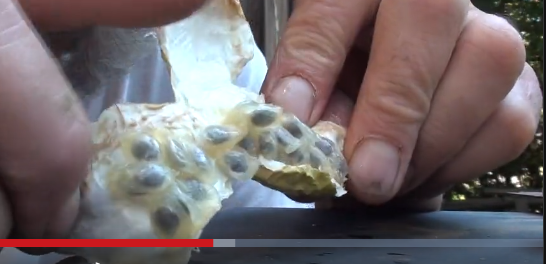
Passiflora incarnata, aka “maypop,” is winter hardy to USDA zone 5 and can be found wild throughout the entirety of the Carolinas (plus west to Oklahoma, south to Florida, and north to at least Illinois). I dug up my colony from the forest edge behind the old Summit Drive Elementary School building the day before the bulldozers came. It’s been a decade since they rebuilt the school so that’s no longer a good place to look. Try local and online nurseries instead. Make sure that you are getting the correct species (Passiflora incarnata) and not one of the tropical or inedible Passiflora spp. To grow them from seed, make sure you are using fresh seeds that have never been dried—the embryos die if they aren’t kept moist. New plants can easily be grown from segments of maypop roots.
Our native passionfruits are green and smooth when unripe and turn yellowish and wrinkled when ready to eat (most kids pop them all long before they get to discover that phase). The insides of ripe maypops look and taste just like the purple, wrinkled Passiflora edulis fruits occasionally found in tropical fruit juice blends and specialty produce sections (usually in poor shape given how far they had to travel from their frost-free climates). A single ripe maypop is so aromatic and fully flavored that it can perfume an entire pitcher of tea or a batch of cake batter. I use the strained flesh interchangeably to vanilla extract and only add the seeds if I want some extra crunch; you can substitute maypop juice for the same quantity of any extract in a recipe. I usually scoop the pulp out with a spoon and rub it against a mesh strainer. Maypop passionfruits keep well on the counter and longer in the fridge, plus the pulp can be frozen for later use.
If you can’t grow them yourself, it shouldn’t be hard to talk a gardener friend into it. Passionflowers are arguably the showiest, most deliciously fragrant flowers in the floral kingdom. For butterfly enthusiasts, its leaves are the caterpillar food plant of both the monarch-like gulf fritillary and the stripey zebra longwing. They have another distinct insect relationship with carpenter bees, which fit like Cinderella’s slipper to pollinate maypop blooms. This may seem like a downside for people who dislike the destructive chewing of carpenter bees, but maypops also happen to be partially carnivorous. When the bees show up, the flower nectar gets them too drunk to leave. After pollination, the bees fall to the ground where they die and break down into fertilizer for the sneaky vine. I rarely see any honeybees or other beloved pollinators on my passionflower blooms, so I don’t tend to mind this sinister side effect that turns house-munching bees into delicious fruit.
▶️ DTube
▶️ IPFS